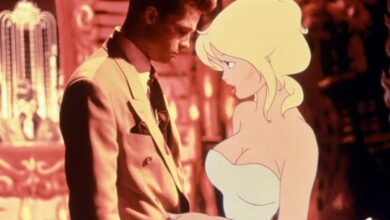To mediocrity and beyond: Does Lightyear speak to a Pixar in crisis?

Lightyear, the latest film by Pixar, is totally fine. It’s OK. Adequate. Mediocre. But for the studio as a whole, this might be the most damning response imaginable. We like to think of Pixar as innovators who changed the landscape of animation with 1995’s Toy Story, and continue to deliver beautiful, thought-provoking, mass-appeal original stories. With 11 Academy Awards for Best Animated Feature to its name, and $14bn in box office returns, Pixar is meant to be proof that success doesn’t always require selling out.
So why does Lightyear, a perfectly serviceable film, feel like such a disappointment? In short, because it’s exactly the kind of cynical, corporate-minded exercise that we always want – and expect – Pixar to rise above. Its premise sounds exactly like something an executive would scribble on a whiteboard and then aggressively circle in red pen. Lightyear is a spin-off of the Toy Story franchise that also isn’t a spin-off of the Toy Story franchise. As tweeted by actor Chris Evans – who voices Buzz – when the film was first announced: “this isn’t [about] Buzz Lightyear the toy. This is the origin story of the human Buzz Lightyear that the toy is based on.” Got that?
We’re truly a million miles away from the miniaturised adventures of the original Buzz (voiced by Tim Allen), who ended Toy Story by chasing after a moving truck. It feels almost quaint in comparison. But it’s startling, too, how different Lightyear feels not only from the Toy Story series but from Pixar’s other, recent output: March’s Turning Red, about a Chinese-Canadian girl who turns into a giant red panda whenever she gets too emotional, and last year’s Luca, where a friendship between two boys and a girl is complicated by the fact the boys are sea creatures. “[Their] stakes are presented as extremely small,” says Dr Sam Summers, an animation academic and one half of the Disniversity podcast, which takes both an academic and personal look at the Mouse’s extensive animation library. “[They’re] really just about these young people living their lives and exploring their own relationships. It’s nice to see that from a big animation studio.”
So what exactly does Lightyear say about Pixar’s future as a studio? Have large-scale and easily merchandisable outings become a necessity? And what does Pixar lose in return? Its reputation? Its cultural clout? Its very soul? A once independent venture co-founded by Steve Jobs, Pixar was acquired by Disney in 2006 and assimilated into its corporate monolith. And though Inside Out director Pete Docter may currently serve as chief creative officer, he still ultimately answers to Disney’s executive board. That presents its own challenges. Over the past year or so, multiple reports have claimed that Pixar’s employees aren’t necessarily happy with the decisions their corporate overlords have imposed on them. An open letter penned in March of this year accused Disney of censoring “nearly every moment of overtly gay affection” in their films. A kiss between two women was cut from Lightyear, and only restored after the letter’s publication. Other reports have suggested that employees at the studio were saddened by so much of their recent output – original, non-franchise films Soul, Turning Red, and Luca – only being released on the Disney+ streaming platform. Lightyear is Pixar’s first film to hit cinemas since before the pandemic. That choice feels deliberate.
Summers is of two minds about it. “I would love to have seen Luca and Turning Red in the cinema,” he says. “But if we have to go to Disney+ to see animation used in more expressive ways to illustrate these more personal stories, I don’t necessarily mind.” Both those films, which drew directly from the childhoods of their respective first-time directors Domee Shi and Enrico Casarosa, felt like a real step forward for the studio. They were also, arguably, the first Pixar films to take any meaningful diversion away from the studio’s standard, in-house animation style – slightly caricatured features; the same repeated “masculine” and “feminine” silhouettes. Luca seemed to almost replicate the look of plasticine; Turning Red borrowed from anime. Lightyear doesn’t just look exactly how you’d expect a Pixar film to look, but it relies heavily on familiar sci-fi movie iconography. “It looks like a Star Wars movie,” says Ben Travis, a journalist and Summers’s co-host on the Disniversity podcast. “The jump to hyperspace? The way that’s animated looks exactly as it does in Star Wars.”
Those recent Pixar films may have been considered too “risky” for theatrical release, but the victory, Travis adds, is that they exist at all. “As long as there is a diversity of content out there, I’m kind of happy with that.” He points to Japan’s thriving anime industry as a good example of that attitude put into practice. “There are movies of varying lengths and budgets,” he says. “And that allows for this extraordinary diversity in terms of the content. Maybe if we diversify our distribution strategies in the West, that will lead to more diverse content. And I do want both. I want your Lightyears and your Lucas coming from the same studio.”
Pixar has, it should be said, been driven by commercial impulses for years. The deeply unmemorable Cars franchise lasted for three films largely because its merchandise was so profitable. The studio’s also become more reliant on sequels, from 2018’s Incredibles 2 to 2019’s Toy Story 4. But it will be interesting to see how the next film on Pixar’s docket, June 2023’s Elemental, fares. For now slated for cinemas, Elemental seems to be about as Pixar-ian as it gets. It posits a world in which the elements – fire, water, land, and air – all have feelings. Lightyear will inevitably make money. That’s the reason it was made. But if Elemental, for whatever reason, underperforms, will Disney learn all the wrong lessons from it and use it as proof that no one wants original ideas any more?
As Pixar’s chief creative officer, Docter has inevitably come up against the exact same pressures as those in charge of Disney’s other subsidiaries – that tension between scale and emotional intimacy, and originality and familiarity, that already guides the decisions of Marvel Studios’ Kevin Feige and Lucasfilm’s Kathleen Kennedy. But Docter knows Pixar’s ethos inside out (pun intended). He’s been a part of the company since day one. He directed Up. He directed Monsters Inc. And Pixar has already successfully cracked the formula before. Just look at Brad Bird’s superhero satire The Incredibles.
Lightyear, at its worst, feels like it’s simply trying to replicate the kind of noisy, effects-heavy blockbusters that every other studio is pumping out on the regular. Pixar, with every tool at its disposal and every drop of imagination in its animators’ heads, proved with The Incredibles that it could make spectacle look like art, and action move with feeling. So, no, there’s no reason to give up hope on Pixar yet, however short Lightyear may have fallen. But there will come a time, sooner or later, when the studio is forced to make a choice – what does it really stand for?
‘Lightyear’ is in cinemas from Friday 17 June




